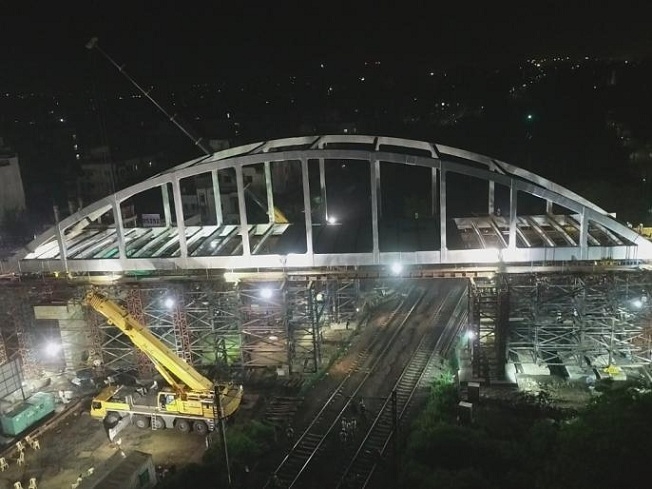Bow String Girder launched after lockdown, other ‘challenges’
27 Sep 2020 01:41:52

Staff Reporter :
The 64-metre long girder was launched after challenges like 4-metre welding in 12-hour shift
The Bow String Girder across Manish Nagar railway crossing presented a wonderful sight on Saturday afternoon. It was launched on Friday late night. In the end, however, lockdown proved to be a bigger challenge than the actual launch of the Bow String Girder. NVP Vidyasagar, Additional General Manager, Nagarjuna Construction Company (NCC), and one overlooking twin projects of Railway Overbridge-cum-Railway Under Bridge (RoB-RuB) at Manish Nagar, told mediapersons during an interaction at the site on Saturday that pushing of 350-tonne of steel girder went off textbook-like but lockdown proved to be a harrowing time.
“It disturbed our timeline, which is now pushed to October end. Also, it pushed the entire company to its limits in search of technical manpower”, he said. From the last week of March till end of May, work at the site remained disrupted as lockdown tied the hands of the company badly. First, the workers went off to their homes. Later, when the work resumed, it became difficult to locate the welder for assembling the 350-tonne Bow String Girder. This type of welding is a very difficult task as a special cabin is erected for it and lifted to topmost portions of the girder to weld the parts.
At a time, in a 12-hour shift, the maximum output one could get was just 4 metres, while the steel girder stretched to 64 metres. Working in an airtight cabin is not an easy job, that too, when one is hoisted nearly 40 metres from ground, Vidyasagar said. But, Vidyasagar said, the challenge before that was to find the right person as locating the RDSO-approved welding vendors was a tough task. Many professionals were just not ready to carry out the tough work as it called for a very tough physique to operate in a closed space and use CO2 during welding of steel. After the parts were welded, they underwent intensive tests outsourced to RITES. It was only after clearance from all authorities that the Friday night launch was cent per cent successful.
The steel girder was placed atop two wheel-sets that gradually glided across the iron rail, put across two ends of pillars of the RoB, that is meant to ease problems faced in moving across the rail tracks to reach Wardha Road. Explaining the process, the senior engineer of NCC stated that the wheel-sets moved so slowly that one could not even fathom when the work got over. One could sense a totally relaxed atmosphere at the work-site during the launch of the Bow Steel Girder even as it passed over rail infrastructure. Replying to a question, Vidyasagar said that they would be taking just one block on Saturday night to remove the false structure put up to push across the steel bridge. To avoid another block during pouring of concrete, the contractor already welded steel plates to the bottom of the bridge that passed over overhead equipment (OHE). The girder was crafted at Pune and transported to the city. Thereafter, a major portion was assembled adjoining the tracks and then placed atop the pillars where the same was kept on tight leash by a tall crane.
Additional lane to offset worries about traffic mix-up’ Manish Nagar RoB integrates with Wardha Road fly-over at Ujjwal Nagar junction where an additional lane is provided on either side to offset worries about traffic mix-up, NVP Vidyasagar told newspersons. Dismissing the apprehension about vehicles moving from Manish Nagar getting caught in traffic flow on fly-over, Vidyasagar said that three lanes were provided in half a km stretch between Sonegaon police station and Jaiprakash Nagar Metro station to ensure that adequate width was available for smooth movement of vehicles. Coloured cones would be affixed throughout the fly-over to segregate the lanes on fly-over.
Manish Nagar RoB has a width of 7.5 metres and would have two lanes. Besides, 1.5 metre space is also going to be available for footpath so that people can move across the tracks with ease. The footpath is going to help, if, at a later stage, Manish Nagar railway crossing is closed permanently by Railways as the RoB is touted to be in lieu of it. That time, the footpath on RoB would be useful for citizens and blunt any criticism at later stage that citizens’ viewpoint was not taken into consideration while closing the level crossing.